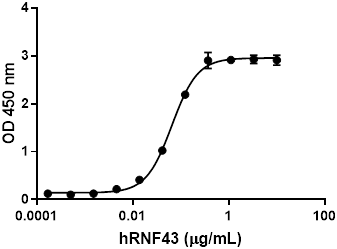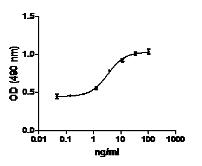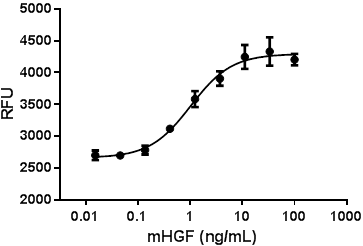- Regulatory Status
- RUO
- Other Names
- NOG, SYM1, SYNS1
- Ave. Rating
- Submit a Review
- Product Citations
- publications
| Cat # | Size | Price | Quantity Check Availability | Save | ||
|---|---|---|---|---|---|---|
| 597102 | 5 µg | 94 CHF | ||||
| 597104 | 20 µg | 218 CHF | ||||
This product is not available for shipping outside of the United States.
Select size of product is eligible for a 40% discount! Promotion valid until December 31, 2024. Exclusions apply. To view full promotion terms and conditions or to contact your local BioLegend representative to receive a quote, visit our webpage.
Noggin is an embryonic inducer that can sequester TGF-β cytokines of the BMP family with extremely high affinity. This protein was originally identified as a BMP-4 antagonist whose action is critical for proper formation of the head and other dorsal structures. Noggin has also been shown to modulate the activities of other BMPs including BMP-2, -7, -13, and -14. It is expressed in defined areas of the adult central nervous system and peripheral tissues such as lung, skeletal muscle, and skin. During culture of human embryonic stem cells (hESC) or neural stem cells under certain conditions, addition of Noggin to antagonize BMP activity may allow stem cells to proliferate while maintaining their undifferentiated state, or alternatively, to differentiate into dopaminergic neurons. Noggin also appears to maintain adult stem cell populations in vivo. For example, it maintains neural stem cells within the hippocampus. Targeted deletion of Noggin in mice results in prenatal death and a recessive phenotype displaying a severely malformed skeletal system. Conversely, transgenic mice over-expressing Noggin in mature osteoblasts display impaired osteoblastic differentiation, reduced bone formation, and severe osteoporosis.
Product DetailsProduct Details
- Source
- Mouse Noggin, amino acids Gln28-Cys232 (Accession# NP_032737.1), with an additional Met at the N-terminus, was expressed in E. coli.
- Molecular Mass
- Recombinant Mouse Noggin is a 46.4 kD disulfide-linked homodimer consisting of two 206 amino acid polypeptide chains. The predicted N-terminal amino acid is Met.
- Purity
- >95%, as determined by Coomassie stained SDS-PAGE.
- Formulation
- Lyophilized
- Endotoxin Level
- Less than 0.1 ng per µg of protein.
- Storage & Handling
- Unopened vial can be stored at -20°C or -70°C. For maximum results, quick spin vial prior to opening. Reconstitute in water to a concentration of 0.1-1.0 mg/ml. Do not vortex. Note: Due to solubility reasons the protein should be kept at low pH. It is recommended to further dilute in a buffer containing a carrier protein such as 0.1% BSA and store working aliquots at -20°C to -80°C. Avoid repeated freeze/thaw cycles.
- Activity
- Mouse Noggin is able to inhibit 5.0 ng/ml of BMP-4 induced alkaline phosphatase production by ATDC5 chondrogenic cells with an ED50 of 1.0 - 2.0 ng/ml, corresponding to a specific activity of 5.0 x 105 - 1.0 x 106 units/mg.
- Application
-
Bioassay
Antigen Details
- Structure
- Cytokine
- Distribution
- Skeletal muscle, lung, neuron, skin
- Function
- Antagonizes BMPs.
- Interaction
- Mesenchymal stem cells
- Ligand/Receptor
- BMPs
- Bioactivity
- mNOG is able to inhibit BMP-4 induced alkaline phosphatase production by ATDC chondrogenic cells.
- Cell Type
- Mesenchymal Stem Cells, Embryonic Stem Cells
- Biology Area
- Cell Biology, Immunology, Neuroscience, Signal Transduction, Stem Cells, Synaptic Biology
- Molecular Family
- Growth Factors, Cytokines/Chemokines
- Antigen References
-
1. Valenzuela DM, et al. 1995. J. Neurosci. 15:6077.
2. McMahon JA, et al. 1998. Genes Dev. 12:1438.
3. Yuasa S, et al. 2005. Nat. Biotechnol. 23:607.
4. Gong Y, et al. 1999. Nat. Genet. 21:302.
5. Chiba S, et al. 2008. Stem Cells 26:2810.
6. Bonaguidi MA, et al. 2008. J. Neurosci. 28:9194. - Gene ID
- 18121 View all products for this Gene ID
- UniProt
- View information about Noggin on UniProt.org
Related FAQs
- Why choose BioLegend recombinant proteins?
-
• Each lot of product is quality-tested for bioactivity as indicated on the data sheet.
• Greater than 95% Purity or higher, tested on every lot of product.
• 100% Satisfaction Guarantee for quality performance, stability, and consistency.
• Ready-to-use liquid format saves time and reduces challenges associated with reconstitution.
• Bulk and customization available. Contact us.
• Learn more about our Recombinant Proteins. - How does the activity of your recombinant proteins compare to competitors?
-
We quality control each and every lot of recombinant protein. Not only do we check its bioactivity, but we also compare it against other commercially available recombinant proteins. We make sure each recombinant protein’s activity is at least as good as or better than the competition’s. In order to provide you with the best possible product, we ensure that our testing process is rigorous and thorough. If you’re curious and eager to make the switch to BioLegend recombinants, contact your sales representative today!
- What is the specific activity or ED50 of my recombinant protein?
-
The specific activity range of the protein is indicated on the product datasheets. Because the exact activity values on a per unit basis can largely fluctuate depending on a number of factors, including the nature of the assay, cell density, age of cells/passage number, culture media used, and end user technique, the specific activity is best defined as a range and we guarantee the specific activity of all our lots will be within the range indicated on the datasheet. Please note this only applies to recombinants labeled for use in bioassays. ELISA standard recombinant proteins are not recommended for bioassay usage as they are not tested for these applications.
- Have your recombinants been tested for stability?
-
Our testing shows that the recombinant proteins are able to withstand room temperature for a week without losing activity. In addition the recombinant proteins were also found to withstand four cycles of freeze and thaw without losing activity.
- Does specific activity of a recombinant protein vary between lots?
-
Specific activity will vary for each lot and for the type of experiment that is done to validate it, but all passed lots will have activity within the established ED50 range for the product and we guarantee that our products will have lot-to-lot consistency. Please conduct an experiment-specific validation to find the optimal ED50 for your system.
- How do you convert activity as an ED50 in ng/ml to a specific activity in Units/mg?
-
Use formula Specific activity (Units/mg) = 10^6/ ED50 (ng/mL)
 Login / Register
Login / Register 














Follow Us